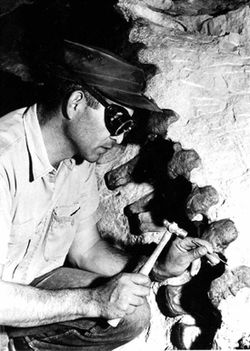Paleontology
2007 Schools Wikipedia Selection. Related subjects: General Geography
| Branches of Zoology |
|
Acarology Arachnology Cetology Entomology Ethology Herpetology Ichthyology Mammalogy Myrmecology Neuroethology Ornithology Paleozoology Paleontology Anthrozoology |
| History |
|
pre-Darwin post-Darwin |
Paleontology or palaeontology (see Spelling differences) is the study of the history and development of life on Earth, including that of ancient plants and animals, based on the fossil record (evidence of their prehistoric existence as typically preserved in sedimentary rocks). This includes the study of body fossils, tracks ( ichnites), burrows, cast-off parts, fossilized feces ( coprolites), palynomorphs and chemical residues. See also paleoanthropology.
Overview
Modern paleontology sets ancient life in its contexts by studying how long-term physical changes of global geography paleogeography and climate paleoclimate have affected the evolution of life, how ecosystems have responded to these changes and have changed the planetary environment in turn and how these mutual responses have affected today's patterns of biodiversity. Hence, paleontology overlaps with geology (the study of rocks and rock formations) as well as with botany, biology, zoology and ecology – fields concerned with life forms and how they interact.
The major subdivisions of paleontology include paleozoology (animals), paleobotany (plants) and micropaleontology (microfossils). Paleozoologists may specialize in invertebrate paleontology, which deals with animals without backbones or in vertebrate paleontology, dealing with fossils of animals with backbones, including fossil hominids ( paleoanthropology). Micropaleontologists study microscopic fossils, including organic-walled microfossils whose study is called palynology.
There are many developing specialties such as paleobiology, paleoecology, ichnology (the study of tracks and burrows) and taphonomy (the study of what happens to organisms after they expire). Major areas of study include the correlation of rock strata with their geologic ages and the study of evolution of lifeforms.
Paleontology utilizes the same classic binomial nomenclature scheme, devised for the biology of living things by the mid-18th century Swedish biologist Carolus Linnaeus and increasingly sets these species in a genealogical framework, showing their degrees of interrelatedness using the still somewhat controversial technique of ' cladistics'.
The primary economic importance of paleontology lies in the use of fossils to determine the age and nature of the rocks that contain them or the layers above or below. This information is vital to the mining industry and especially the petroleum industry. Simply looking at the fossils contained in a rock remains one of the fastest and most accurate means of telling how old that rock is.
Fossils were known by primitive humans and were sometimes identified correctly as the remains of ancient lifeforms. The organized study of paleontology dates from the late 18th century. For a more complete historical overview see the article History of paleontology.
Notable paleontologists
History includes a number of prominent paleontologists. Charles Darwin collected fossils of South American mammals during his trip on the Beagle and examined petrified forests in Patagonia. Mary Anning was a notable early paleontologist. She found several landmark fossils, in her home town of Lyme Regis. Although self-taught, she collected and described them in a very systematic way. William Buckland, Richard Owen, Gideon Mantell, Georges Cuvier and Thomas Huxley were important early pioneers, in the field of paleontology. Thomas Jefferson took a keen interest in mammoth bones. Edward Drinker Cope and Othniel Charles Marsh waged a famously fierce competition known as the Bone Wars in the late 19th century that involved some questionable practices, but which significantly advanced the understanding of the natural history of North America and vertebrate paleontology. Besides looking at mammal teeth and unearthing penguin skeletons, George Gaylord Simpson played a crucial role in bringing together ideas from biology, paleontology and genetics, to help create the 'Modern Synthesis' of evolutionary biology. His book "Tempo and Mode" is a classic in the field. Prominent names in invertebrate paleontology include Steven Stanley, Stephen Jay Gould, David Raup and Jack Sepkoski, who have done much to expand our understanding of long-term patterns in the evolution of life on earth. Large names in the field of paleoanthropology include Louis, Mary and Richard Leakey, Raymond Dart, Robert Broom, C.K. 'Bob' Brain, Kenneth Oakley, Robert Ardrey and Donald Johanson. In recent times, Mongolian paleontologist Rinchen Barsbold has done much to expand our understanding of dinosaur and bird evolution.

